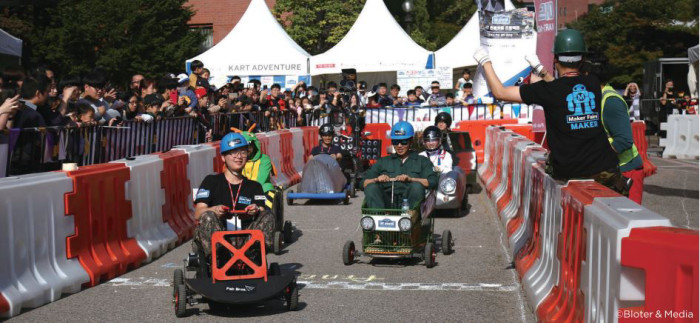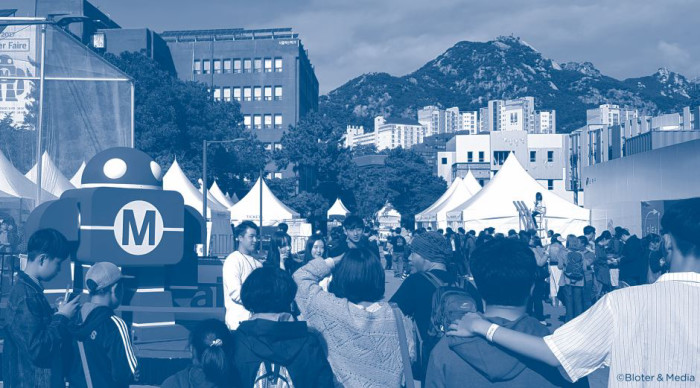경기문화재단
Maker Movement
Cultural Policy Bulletin Vol. 6
Cultural Policy platform 1
Hee Jung
Make: Korea Team Manager at Bloter & Media
Make: Editor / Maker Faire Seoul Director
What does “maker” mean? Who can be called maker? We often hear this word recently but it is not really a commonly used term. We can just assume that the word newly defines a culture of making by hearing it with its new meanings. Before starting the story of makers and their culture, I would like to introduce definitions of jargons regarding the Maker Movement.

The Cart Adventure, a race of DIY-based, single-passenger cars.
Makers don't always conduct just easy projects. Maker Faire Seoul 2017
Maker – A maker is a person making something. Unlike the existing inventors, craftspeople, artists, technicians and those doing DIY as a hobby, makers make the best use of the techniques they can use on the basis of the knowledge they gain from each other. Makers could also be called a “new population of production” that has naturally emerged with the sharing of knowledge and technological development.
Maker Movement – This movement refers to a cultural trend where those who make something what they need share their knowhow and develop how they work. At the beginning, some of the world’ influential leaders such as Dale Dougherty (founder of Make: Magazine), Mark Hatch (former CEO of TechShop) and Chris Anderson (founder of 3D Robotics) rapidly spread this culture both online and offline. Today, a great number of individuals and businesses are leading this trend.
Make: Magazine – Founded in 2005 in the US, this magazine is focused on makers’ stories and project knowhow. The magazine has contributed to sharing with the public makers‘ projects that had mostly stayed only in their personal space. Its Korean edition was first published in 2011.
Maker Faire – This festival was launched in 2006 after the founding of Make: Magazine. Gathering together people and projects appearing in the magazine, the event has grown into the global makers’ festival. Today, this festival is held in about 40 countries over 200 times a year. In Korea, Maker Faire Seoul, which is Korea’s largest maker event, has taken place since 2012.
Makerspace – A makerspace is a space that has diverse tools (e.g. 3D printer, CNC machine and laser cutter) to facilitate making activities. For a given makerspace, a community successfully utilizing the space is more important than its list of tools.
* For more information and stories, please visit this website: make.co.kr
The term “maker,” which has the meaning we use today, first appeared in 2005 with the fist edition of Make: Magazine. Meanwhile, its first appearance in Korea’s printing media was through the Korean edition of the magazine in 2011. The term has been used for 13 years and it has spread throughout the world as a concept but it still sounds new to many. Dale Dougherty, then editor of Make: Magazine, used this term to call those around him who make something. As they were making products in a way different from the existing one, he came up with this new term.
Long before the use of the term “maker,” humans were already making something naturally from ancient times. That is why they are called homo faber, tool users. Making something with one’s own hands is actually an instinctive act; it is difficult to describe this act more simply than that. We don’t need to see or listen to others to understand this concept. Let us think about our own experience; the tasks we carry out ourselves stay in our memories vividly. What is then the reason of reflecting on the concept of “making” again with this new term?
It is certain that over the past decade, we have been both familiar with and far from making something in our daily life. Everyone has a desire to make something. However, with the development of modern technology, it is difficult to strike a balance between what we can do and what others can do for us, considering cost-effectiveness. Fox example, let’s say that we need to choose between cooking and buying a meal for breakfast. Sometimes, it is much cheaper. easier and more satisfying to buy a meal than cooking. Other examples are cars, mobile phones and other goods we can enjoy at a certain cost. Consequently, we sometimes don’t even think of choosing to make and install something on our own from the first place.
Nevertheless, there are those who don’t care about such cost-effectiveness to just make something new. It doesn’t mean that they appeared out of the blue. They had already been making something at their home, storage and studio and they came to draw public attention gradually. Full of enthusiasm, they make products that could be seen as either great or ordinary, depending on points of view. They are actually “amateur-like” people. One of them collected ice pop sticks to make a tripod for a camera to take aerial photos. Another person wrote a serious report on how to escape from reality. MIT’s Fab. Lab. (workshop) taught us how to make (almost) everything in the world, shocking many at that time. Serious makers’ activities had already been taking place around us. They just hadn’t been known to the public.
"The future is already here — it's just not very evenly distributed."
- William Gibson
Make: Magazine has introduced these makers and their projects that hadn’t been known to the public. The magazine also provides real-time updates on their projects through its website. In 2006, it also launched a festival called Make Faire so that makers can meet each other in person to share their joy of making. People gradually came to share online and offline their knowhow of making products, thus expanding their network around the world. Each maker’s ideas and projects have transcended national boundaries. This could be called a grassroots technological revolution. Soon afterward, makers started their big and small meetings not only in the US (White House) but also in other continents including Asia, Europe, Africa and the Middle East. Nowadays, we can meet makers easily at their communities (e.g. makerspaces, hackerspaces and dorkbot) or at Maker Faire.
Behind the Maker Movement lies today’s environment where individuals can make their own products thanks to technological development. The expansion of open knowledge has also contributed to this movement. Now, you don’t have to be an electronic engineer to make a circuit, get your product from a machine on your desk and gain expertise at different forums. Of course, at the center of this is each maker’s joy. The facial expression of makers, who make and share their products enthusiastically, tells us that they feel proud of themselves, as if they were saying “I made it!”
These makers are at the heart of the Maker Movement. Amateurs are playing an important role. Non-professional makers just learn what they need to solve their imminent problems. To them, the depth of their technological knowledge doesn’t matter because if necessary, they can refine it later on. When an old TV’s leg is broken, nobody would operate an outdated factory to repair it. Instead, you could make a new leg through 3D printing or simply pile books under the TV. What matters is to solve your problem. Indeed, amateurs have solved their problems by talking to each other online and offline and by trying different methods. As a result, they have made a wide spectrum of creative projects.
Among these diverse projects, the ones that have gained popularity are mostly simple and amusing projects. A case in point is a project called LED Throwie. The project is about making a shining module by putting a battery between LED’s legs and by fixing them with double-sided tape. In large quantities, this module allows you to write something on buildings’ walls with light or to throw a “light bomb” to a bus. With its interesting expression tool, this project drew great attention. The project also shared how to make the module on its knowhow-sharing website called Instructables (instructables.com), thus contributing to filling many cities with light.
Makers have continued to carry out projects at different levels of difficulty, providing a lot fun. However, this trend, which is based on production, hasn’t been confined to simple fun. When Maker Faire was held at the White House in 2014, President Obama said, “Today’s DIY is tomorrow’s ‘made in America.’” The US has been seen as a country that is traditionally weak in manufacturing so it seems to be invigorating this industry through the Maker Movement. Meanwhile, not only the US but also many other countries want to be equipped with a strong manufacturing industry. Under these circumstances, if an individual or several people manage the process between devising ideas and making products, they could even lead to a shift in the national economy. Indeed, products that are born from makers’ ideas tend to be made in their country continuously. For instance, the Arduino board, open-source hardware, is produced in Italy, the country of its developer Massimo Banzi.
* As for makers’ economic ripple effects, please refer to Makers: The New Industrial Revolution by Chris Anderson.

Maker Faire Seoul 2017
Fortunately, the Maker Movement, which has great potential, hasn’t changed to become too pedantic or commercial. In other words, “makers” still mean those who enjoy making something with great enthusiasm. It is difficult to estimate the number of makers because they don’t have particular qualifications other than their activities of making. Nevertheless, the number of the participants of Maker Faire, makers’ festival, statistically implies people’s growing interest in the Maker Movement. In 2017, a total of 221 Maker Faires, which include Maker Faire Seoul, took place around the world to attract 1.58 million visitors.
It took a little more than ten years to make the Maker Movement known around the world as it is today. In Korea, diverse maker projects, which were launched around 2010, are now growing further. We don’t know where the Maker Movement will take us yet. As an international cultural trend, the movement is just at its beginning now.
<ggc의 모든 콘텐츠는 저작권법의 보호를 받습니다.>